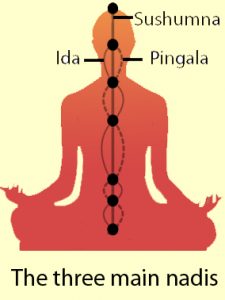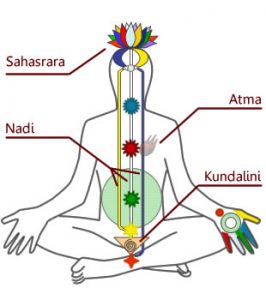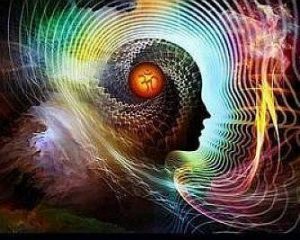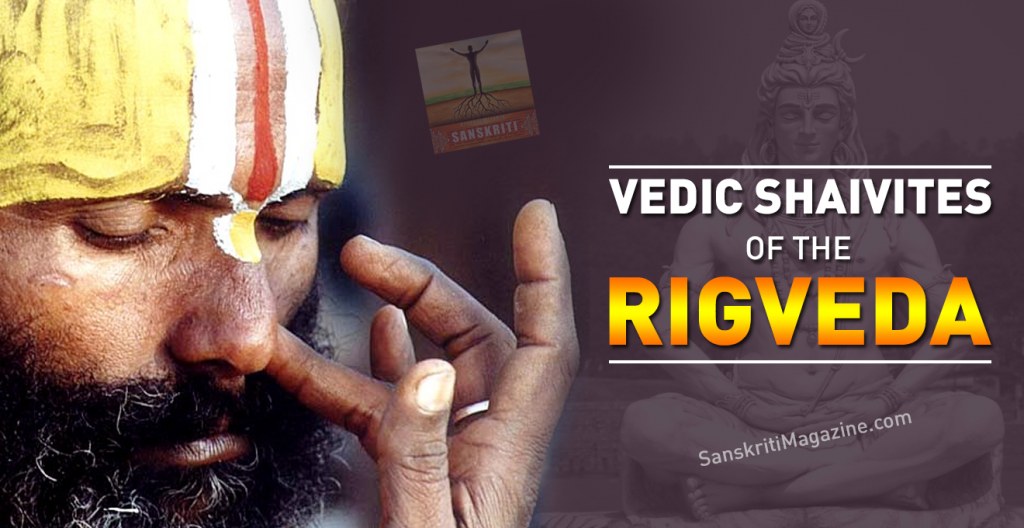~ By Santosh Kumari / – संतोष कुमारी
We find interesting reference in Rigveda about a group of seers who are known as Keshins as well as Vratyas. They are the early Shaivites.
These seers are described as having long hair and wear yellow clothes. What is most relevant about them is their use of air as a string or girdle. Characterized as such, they are said to follow the movement of air by which they enter into the domain of gods. (Rigveda, X.136.2)
The use of air as a girdle or string suggests their rigorous sadhana on prana. Girdle is worn around the waist at the meeting point of the two main pranas, namely, prana and apana. It is just to help in the harmonizing these two pranas which are important not only for the continuance of life but also for the lifting one to higher states of consciousness. Use of air as the girdle by these seers indicates that they had perfected themselves in this sadhana by which they entered into the domain of gods. By the use of prana sadhana, they gained access to higher state of consciousness which the domain of gods represents.
 The girdle comprises of three strings of air. It means pranas. In our body there are ten pranas but three are important ones, namely, ida, pingala and sushumna. Ida and pingala are left and right pranas while sushumna is in the middle. We either breathe from one nostril and sometimes with the other. They represent the sun and the moon. Right nostril breathing gives us heat and makes us agitated as well as improves digestion. Left nostril breathing when active cools our body, calm the mind. But when they are balanced, then the breathing is through sushumna.
The girdle comprises of three strings of air. It means pranas. In our body there are ten pranas but three are important ones, namely, ida, pingala and sushumna. Ida and pingala are left and right pranas while sushumna is in the middle. We either breathe from one nostril and sometimes with the other. They represent the sun and the moon. Right nostril breathing gives us heat and makes us agitated as well as improves digestion. Left nostril breathing when active cools our body, calm the mind. But when they are balanced, then the breathing is through sushumna.
In Sushmna nadi resides the kundalini, it gets aroused and moves towards sahsharara chakra. The mind becomes tranquil, everything is balanced. All duality vanishes. This is the ultimate state of consciousness, where the source of all that we observe in the universe is known. The yogi then realizes his true nature and that of the universe and multiverses. Thus, it is said Sarvam khalu idam brahma, all this is Brahman only and tat tvam asi – You are That, aham brahma asmi, I am Brahman, amritasya putrah, you are the son of immortal, etc. This is the meaning of second paragraph.
Vak is speech. It has four levels, para vak, akin to turiya (the transcendental state); pashyanti, sushupti where it starts manifesting, in madhyama it’s in the form of thoughts and ideas and vaikhari, form of speech. Manas is the apparatus which contains mind, buddhi, etc. which are activated by prana, the vital force and they coordinate; but in ordinary human beings they create agitation and fickleness. Man thus becomes the slave of them.
The next mantra of this hymn emphasizes on another aspect of their sadhana that is silence. It reads as follows:
We have become delighted through observance of silence and have settled ourselves on airs. You mortals see only our body. (Rigveda, X.136.3)

Observance of silence on the part of these yogis, indicate that they followed the rigorous course of discipline. Since vak is the medium of manifestation of consciousness and for reversion to consciousness in its pure form, it is essential to discipline one’s power of speech. Discipline of speech is important in prana sadhana since the apparatus of speech cannot work without the help of prana.
Introversion of prana through the discipline of vak results in the expansion of the horizon of the inner being, which ultimately elevate the consciousness to the state of divine. This is what they indicate in the next of mantra of the hymn:
“The muni takes his flight in the intermediate space and looks closely into all the forms of the world. He, thus, becomes established in the friendship of the god of gods for the sake doing noble deeds.” (Rigveda, X.136.4 )
Flying in the intermediate space may refer to muni’s siddhi attained through the control on is vital forces. In any case, it is through the sadhana of control over his prana that has been enabled to take flight in the sky. Much more than that what the mantra seems to refer to is, his flight in the space of consciousness (khecara). Since it is through such a flight that one can have the possibility of reaching the God of gods and getting established in His friendship. The last of the mantra is also significant as it states that the muni has ascended that state for friendly participation in God’s noble deeds. It is by elevation in one’s consciousness that one can think of the universal good and not by flying in the sky.

How he gets himself elevated to this state happens to be re-stated in a symbolic form in the second last mantra of the hymn, which states:
“By treading the path of Apsarasas, Gandharvas and deers, the Keshin, having become cognisant of real knowledge has become friendly with the Divine and sweet and exhilarated in delight.” (Rigveda, X.136.5)
Taking Apsaras as symbolic of manas, Gandharva as that of vak and deer as that of prana, we can assume that the path by treading which the Keshin reached the blissful state of the Divine was none but one of discipline of manas, prana and vak on the yogic line. It is by virtue of this sadhana and the consequent enlightenment that he is said in the last mantra of the hymn to take drink in a cup of visha in the company of Rudra.
What visha stands for in this context is difficult to decide but one thing is obvious that it is something stimulating and exhilarating. Perhaps the word visha may stand for kundalini as is evident in the Tryambaka system now known as Kashmir Shaivism. What is significant is the company of Rudra in which the drink is being taken at that highest plane of being which could be attained by undergoing the discipline of vak, prana and manas. As is evident from the context, the God of gods in whose friendship the Keshin is said to have entered, is none but the Rudra of this last mantra in whose company the Keshin is said to take the drink. The mantra reads as follows:
“The air churned out for the sake of him and turned into a paste what otherwise was difficult to turn as such so that the Keshin takes it in a cup of visha in the company of Rudra.” (Rigveda, X. 136.7)
Here air may be taken to represent prana, which renders vak into a paste so as to make it get assimilated to manas in its purified form, as represented by the Keshin.
On the basis of the analysis of this hymn, we are in a position to point out that Shaivism flourishing in diverse forms such as in Kashmir and South India also in the form of various devotional paths of somewhat obscure nature, has inherited its rigour of sadhana in regard to vak and prana from Vedic hymns like this.
This point gets confirmed from the Shivadrishti of Somananda, one of the earliest exponents of Kashmir Shaivism.
While giving an outline of his tradition and lineage, he states that all the secret traditions, including the Shaiva as also the method of entering into them were lying originally kept concealed in the mouths of the seers and that with the advent of the Kali age these became difficult to understand.
In view of this, continues, Somananda, while loitering on Kailasha, Lord Shiva, thinking of the welfare of mankind, came down from the mountain and imparted the secret knowledge to Durvasa, a muni leading a life of perfect celibacy (Shivadrishti, VII. 2.1, 2, 4). If we collate this account of Somananda with this Rigvedic hymn, it becomes obvious that Muni Durvasa is most probably no one else but the leader of the munis clad, moving with the speed of air, using air as a string to ascend the sky and reach the domain of the God of gods so as to participate in the latter’s task, of doing good to people at large.
The Åñis in whose mouth the great secrets are said to have lain, cannot be anyone except for the Vedic seer keeping the mantras preserved in him through the oral tradition.
Thus, what seems most likely to have happened is that the Veda had embedded in it seeds of all the subsequent traditions of sadhana, both yogic and sacrificial. While the sacrificial was taken up and carried towards by the Brahmanas, the yogic came to be taken up and developed partly by the Upanishads. Shiva’s benevolence towards all living beings, as indicated in the Shivadrishti has its seed in the Rigvedic hymn’s account how the muni becomes friendly to Rudra for the sake of promoting His cause of welfare to all.
Yoga enables one to reach the highest state of consciousness via whatever openings the individual is provided with by Nature for the manifestation of consciousness through him. Such three main avenues are prana, vak, and manas. It is with the development of the method of breathing in and breathing out that a collocation of matter becomes organic and begins to be imbued with traces of consciousness. With the development of manas in the organic being consciousness meets the possibility of its manifestation to any extent. In this colossal range of the development process vak plays a vital role. It serves the medium of intercommunication among organic beings resulting in accentuation and expedition in the developmental process through coordination of individual efforts. Efficacy of vak in this process is evident from the difference man has been able to make over and above the animal life.
Vak is primordial sound which vibrates in the cosmos. It is a wave emerging from consciousness and assumes the form of sound due to friction generated by the vibration. The vibration, in its turn, is caused by the principle of delight which lies in the consciousness, both in the state of acceleration as well as impediment. In other words, when the principle of delight gets accelerated or impeded, it generates some sort of vibration which on getting some sort of friction at any point, gets transformed into sound, voice or word and comes to be given the generic name Vak.
Delight is inherent in existence and consciousness. It is the source of the wave of Vak and its vibration. The wave of the ocean symbolises its mode of manifestation as well as its universality. Vibration as such, the wave of delight becomes and the source of the word.
Aitareya Brähmana equates Vak with the sea and gives the rationale of this equation in terms of imperishability of Vak and sea both in common (Aitareya Brahmana V.16). The imperishability of the sea is due to its depth as well as extensity so is the case with Vak. If the depth of the sea touches the rock-bottom of the earth, the depth of Vak also touch the rock-bottom of the Reality extending from the inert to the superconscient in all their universality.
The problem is how to have access to Vak which is the seed and essence of the Creation.
In this regard, the following statement from Aitareya Aranyaka is significant. According to it, manas is the prior syllable of the phoneme and vak while prana serves as the factor of conjunction between the two (Aitareya Aranyaka, III.1.1). Through this statement what the Aitareya Aranyaka suggests is the interrelationship among the three openings to consciousness which we are provided with.
This illustration suggests that a yogin may be able to realise even the Ultimate Reality within himself through the proper use of the three powers he is endowed with namely, manas, vak and prana. Among these, manas is primary and vak secondary to it while prana serves as the factor of interconnection between the two. This interconnection among these three human capabilities suggests that when manas forms the source of vak through the power of prana, it can be very well be approached in its essence by following the lead of vak and prana.
वैदिक शैव
ऋग्वेद में हमें ऋषियों के एक समूह के बारे में दिलचस्प संदर्भ मिलते हैं, जिन्हें केशिन (लम्बे बाल रखने वाले) या व्रात्य, जिन्होंने व्रत लिया हो के नाम से भी में जाना जाता है। वे सबसे प्राचीन शैव हैं। इन्हें लंबे बाल और पीले कपड़े धारण करने वाले के रूप में वर्णित किया गया है। उनके बारे में सबसे अधिक प्रासंगिक और विशेष बात यह है कि वे वायु को एक तार या करधनी (कमरबंध) के रूप में इस्तेमाल करते हैं। इस तरह के रूप में वर्णित, वे वायु के संचार (गति) का पालन करके देवताओं के क्षेत्र में प्रवेश करते हैं। (ऋग्वेद, X.136.2)
वे तार या कमरबंध के रूप में हवा का इस्तेमाल और कठोर साधना का सुझाव देते हैं। कमरबंध, कमर के चारों ओर दो मुख्य प्राणों – प्राण और अपान के मिलन बिंदु पर पहना जाता है। कमरबंध इन दो प्राणों को सुव्यवस्थित करने में मदद करने के लिए है, जो न केवल जीवन की निरंतरता (नित्यता को) रखने के लिए बल्कि चेतना को उच्च आयाम पर ले जाने के लिए महत्वपूर्ण है। इन ऋषियों (केशिन) के द्वारा कमरबंध के रूप में वायु का उपयोग यह इंगित करता है कि उन्होंने इस साधना में खुद को सिद्ध कर लिया था जिसके द्वारा वे देवताओं के क्षेत्र में प्रवेश कर सके। प्राण साधना के उपयोग से, उन्हें उच्च स्तर चेतना में प्रवेश मिलता है जो देवताओं के क्षेत्र का प्रतिनिधित्व करती है।
वास्तव में कमरबंध में तीन धागे होते हैं। यहां वायु को कमरबंध की उपमा के रूप में लिया गया है और वो भी तीन डोर के रूम में। हमारे शरीर में दस प्राण हैं लेकिन तीन ही महत्वपूर्ण हैं, अर्थात्, इड़ा, पिंगला और सुषम्ना। हम एक नथुने से सांस लेते हैं और कभी दूसरे से। वे चंद्रमा और सूर्य का प्रतिनिधित्व करते हैं। दायीं नाक से साँस लेने से हमें गर्मी मिलती है और हम उत्तेजित होते हैं और पाचन में सुधार भी करते हैं। बाएं नथुने से श्वास जब सक्रिय होती है तो हमारे शरीर को ठंडक मिलती है और मन शांत हो जाता है। लेकिन जब वे संतुलित होते हैं तो श्वास सुषम्ना के माध्यम से होता है। सुष्मना नाडी में कुंडलिनी रहती है, यह उत्तेजित हो जाती है और उर्ध्वगामी हो कर सहस्र चक्र की तरफ चली जाती है। बाएं नथुने से श्वास जब सक्रिय होती है तो हमारे शरीर को ठंडक मिलती है और मन शांत हो जाता है। लेकिन जब वे संतुलित होते हैं तो श्वास सुषम्ना के माध्यम से होता है। सुष्मना नाडी में कुंडलिनी रहती है, यह उत्तेजित हो जाती है और उर्ध्वगामी हो कर सहस्र चक्र की तरफ चली जाती है। मन शांत हो जाता है, सब कुछ संतुलित हो जाता है। सभी द्वैत और द्वन्द नष्ट हो जाते हैं। यह चेतना की परम अवस्था है, जहां पर हम जो ब्रह्मांड में देख रहे हैं उसके स्रोत जान लेते हैं। योगी तब अपनी सच्ची प्रकृति, ब्रह्मांड एवं कई ब्रह्माण्डों का एहसास करते हैं। इस प्रकार, यह कहा जाता है कि सर्वं खलु इदं ब्रह्म, यह सब ब्रहमन ही है और तत त्वं असी – तुम वही हो, अहम ब्रह्मास्मी, मैं ब्रह्म हूं, अमृतस्य पुत्रः, आप अमर्त्य के पुत्र हैं, आदि। यही दूसरे अनुच्छेद का अर्थ है।
वाक् एक वाणी है। इसमें चार आयाम हैं, परा वाक्, तुरीया (ज्ञानातीत); पश्यन्ति जहां वाणी, स्पंदन (कंपन) के रूप प्रकट होती है, मध्यमा में यह विचारों और कल्पनाओं के रूप में और वैखरी में यह वाणी के रूप अभिव्यक्त होती है। मनस वह तंत्र है जिसमें मन, बुद्धि, अहंकार, आदि शामिल हैं और उन्हें प्राण सक्रिय रखता है और वे समन्वय करते हैं, लेकिन सामान्य मनुष्य में वे अस्थिरता और उत्तेजना करते हैं। इस प्रकार मनुष्य उनका दास बन जाता है।
इस ऋचा के अगले मंत्र में उन्होनें साधना के एक अन्य पहलू पर भी जोर दिया है और वह है मौन। जो निम्नानुसार है:
“हम मौन के पालन के माध्यम से मुदित हो गए हैं और खुद को वायु में बसा लिया है। आप मर्त्य केवल हमारे शरीर को ही देखते (देख पाते) हैं (ऋग्वेद, X.136.3)
इन योगियों के द्वारा मौन का पालन करने से पता चलता है कि उन्होंने कठोर अनुशासन का पालन किया होगा। चूंकि वाक् चेतना की अभिव्यक्ति का माध्यम है और उसके शुद्ध रूप में चेतना को पुन: प्रत्यावर्तन करने के लिए, वाणी की शक्ति का अनुशासन आवश्यक है। प्राण साधना में वाणी का अनुशासन महत्वपूर्ण है क्योंकि प्राण की सहायता के बिना वाणी के उपकरण काम नहीं कर सकते हैं।
प्राणों के अनुशासन के माध्यम से एवं प्राण की अंतर्मुखता के कारण संकुचित (सिकुड़ा हुआ) चेतना का विस्तार होता है, जो अंततः चेतना को दैवीय अवस्था में स्थापित करता है। यही वे ऋचीका के अगले मंत्र में दर्शाते हैं:
“मुनि मध्यवर्ती अंतरिक्ष में अपनी उड़ान लेता है और दुनिया के सभी रूपों को बारीकी से देखता है, इस प्रकार, वह अच्छे कर्मों से देवताओं के देवता के साथ दोस्ती स्थापित कर लेता है। ” (ऋग्वेद, X.136.4)
मध्यवर्ती अंतरिक्ष में उड़ान, मुनी की सिद्धियों को सूचित करता है जो उसने जीवनप्रद शक्तियों पर नियंत्रण करने से प्राप्त की। बहर हाल जो भी हो, वह अपने प्राण के नियंत्रण की साधना के माध्यम से आकाश में उड़ान भरने में सक्षम हो जाता है। जितना भी मंत्र में उल्लेख है, वह अत्याधिक है, शायद उसकी उड़ान चेतना के आकाश में है जिसे हम योग की परिभाषा में खेचर के नाम से जानते हैं। खे का अर्थ होता है आकाश और चर का मतलब भ्रमण करना – यानी चेतना के आकाश में भ्रमण करना या स्थापित हो जाना, क्योंकि सिर्फ ऐसी चेतना की उड़ान (खेचर) के माध्यम से ही देवताओं के देवता तक पहुंचने पर ही उनसे दोस्ती स्थापित हो सकती है। इसी मंत्र का अंतिम उल्लेख महत्वपूर्ण है क्योंकि मुनि उस अवस्था में तब पहुंचा जब उसने भगवन के अनुरूप अच्छे सार्वभौमिक कर्म किये। यह तब होता है जब संकुचित चेतना में विस्तार होता है अर्थात वह अपने स्वरूप में स्थापित हो जाती है और जब उसमें उन्नयन होता है तब ही कोई सार्वभौमिक रूप से अच्छा सोच सकता है न कि आकाश में उड़ने से। यही अर्थ है आकाश में उड़ने का जो आगे जा कर कश्मीर शैव प्रणाली में विस्तार से वर्णित है।
वह कैसे खुद को इस अवस्था में ऊपर उठा लेता है, इस ऋचा के दूसरे अंतिम मंत्र में प्रतीकात्मक रूप में फिर से कहा गया है:
“अप्सराओं, गंधर्व और हिरणों के मार्ग पर चलने से, वास्तविक ज्ञान से परिचित होने पर, केशिन, दिव्य के साथ मैत्री कर लेता है और मधुर आनंद से आन्दित हो जाता है।” (ऋग्वेद, X.136.5)
अप्सराओं को मनस के प्रतीक के रूप में लेना, गंधर्व और प्राण को वाक् और हिरण के रूप में, तब हम यह मान सकते हैं कि केशिन दैवीय आनंदमय अवस्था में पहुंचे थे, परन्तु वो भी मनस, प्राण और वाक् के योगिक अनुशासन के द्वारा। इस योगिक साधना के आधार पर और प्रबोध ज्ञान का उदय होने पर ऋचा के अंतिम मंत्र में कहा गया है कि वह रुद्र के संग विष का प्याला पीता है। इस संदर्भ में, विष का मतलब क्या है, यह तय करना मुश्किल है, लेकिन एक चीज स्पष्ट है कि शायद यह कुछ उत्तेजक और प्राणपोषक पेय हो सकता है। विष शब्द कुण्डलिनी के लिए भी इस्तेमाल किया जाता है जैसा कि त्र्यंबक प्रणाली में स्पष्ट है जो अब कश्मीर शैववाद के नाम से जाना जाता है कि जब कुण्डलिनी जाग्रत होती है तो पुरे शरीर में व्याप्त हो जाती है जैसे विष व्याप्त हो जाता है। त्र्यंबक प्रणाली में कुण्डलिनी को विष भी कहा गया है। महत्वपूर्ण यह है कि रुद्र के संग में जो पिया जा रहा है वह चेतना के उच्चतम अवस्था में लिया जा रहा है, जो वाक्, प्राण और मनस के अनुशासन से ही प्राप्त किया जा सकता है। जैसा कि संदर्भ से स्पष्ट है, देवताओं के देवता जिनकी दोस्ती में केशिन ने प्रवेश किया है, वो और कोई नहीं है बल्कि इस अंतिम मन्त्र के रूद्र हैं जिसके संग केशिन को विष पीने के लिए कहा जाता है। मंत्र निम्नानुसार है: “वायु को उसके (चेतना) लिए मंथन किया और उसे (वाक्) गारा में बदला गया जो अन्यथा मुश्किल हो गया था, इसलिए केशिन ने रूद्र के संग विष का प्याला पिया।” (ऋग्वेद, X.136.7) यहां वायु को प्राण के प्रतिनिधित्व के रूप में लिया जा सकता है, जो वाक् को एक लेई (गारे) में बदल देता है ताकि मनस में शुद्ध रूप में आत्मसात किया जा सके, जैसा केशिन द्वारा दर्शाया गया है।
इस ऋचा के विश्लेषण के आधार पर, हम यह बता सकते हैं कि शैव धर्म जो कश्मीर और दक्षिण भारत में विभिन्न रूपों में मिलता है और कुछ अन्य अस्पष्ट प्रकृति के विभिन्न शैव संप्रदायों के रूप में, इन सबको वाक्, प्राण और मनस की कठोर साधनाएं वैदिक विरासत से मिली है। कश्मीर शैव धर्म के शुरुआती दशकों में से सोमानंद की शिवदृष्टि नामक शास्त्र से इस बात पुष्टि होती है। अपनी परंपरा और वंशावली की रूपरेखा देते हुए, वे बताते हैं कि शैव सहित सभी गुप्त परंपराएं और उन में प्रवेश करने की विधि मूल रूप से संतों के मुंह में छिपी हुई थी और यह कलयुग के आगमन के साथ इन्हें समझना मुश्किल गया था। इस बात को ध्यान में रखते हुए, सोमानन्द बताते हैं कि कैलाश पर विचरण करते हुए भगवान शिव मानव जाति के कल्याण के बारे में सोचते हुए, पहाड़ से नीचे उतरे और गुप्त ज्ञान को दुर्वासा मुनि तक पहुंचाया (शिवदृष्टि, VII. 2.1, 2, 4) दुर्वासा मुनि ब्रह्मचारी थे और शायद मुनियों का नेतृत्व करते रहे होंगे जो हवा की गति से आगे बढ़ते हुए, हवा के द्वारा आकाश में उड़ते हुए और देवताओं के देवता के क्षेत्र तक पहुंचने के बाद में दिव्य कार्यों में भाग ले सकें और मानव के लिए अच्छा कर सकें। जिनके (ऋषियोँ) मुंह में महान रहस्य हैं, वे कहते हैं कि वैदिक दृष्टा के अलावा मौखिक परंपरा के माध्यम से उनमें संरक्षित मंत्र रखने के लिए ऋषियों के अलावा कोई उपयुक्त नहीं हो सकता।
इस प्रकार, जो कुछ भी होने की संभावना है, वह यह है कि वेद में साधना के बाद की सभी परंपराओं में योग और यज्ञ दोनों के बीज शामिल थे। यद्यपि ब्राह्मणों ने यज्ञ को अपनाया और उपनिषदों ने योग। सभी जीवित प्राणियों के प्रति शिव की कृपा, जैसा कि शिवद्र्ष्टि में दर्शाया गया है, इस ऋग्वैदिक ऋचा में उसका बीज है कि मुनियों को सभी के कल्याण के लिए, उनके उद्देश्य को बढ़ावा देने के लिए वे रुद्र के अनुकूल हो जाते हैं।
योग एक ऐसा माध्यम है जो चेतना की उच्च अवस्था पर ले जाता है और वो माध्यम प्रकृति द्वारा हमारे शरीर में प्रदान किया गया है। ये प्राकृतिक माध्यम तीन हैं — प्राण, वाणी और मनस। श्वास की विधि के विकास यानी श्वास करने की विधि के विकास के साथ सांस का लेना और सांस का बाहर जाना पदार्थ के विकास क्रम में एक संघटन है जो अंततः चेतना से ओत प्रोत हो जाता है। जीव में मनस का विकास होते ही चेतना अपने आप को अभिव्यक्त करने के नाना प्रकार के रास्ते खोज लेती है तो अपने आपको चार आयाम में विभक्त कर लेती है। विकास प्रक्रिया के इस अति विशाल क्रम में वाक् एक महत्वपूर्ण भूमिका निभाती है। यह (वाक्) जैविक प्राणियों के बीच अंतः संचार के माध्यम से अपने आप को सुस्पष्ट करती है। इस प्रक्रिया में, वाक् की प्रभावकारिता मनुष्य को पशु जीवन से अलग करती है।
वाक् आदि ध्वनि है जो ब्रह्मांड में व्याप्त है। यह चेतना से उत्पन्न एक लहर है और कंपन द्वारा उत्पन्न घर्षण के कारण ध्वनि के रूप को ग्रहण करती है। यह कंपन (स्पंदन), आनंद की उत्त्पति, आनंद के सिद्धांत के द्वारा ही चेतना में निहित है दोनों ही अवस्थाओं में – आनंद की वृदि या उसकी बाधा में। दूसरे शब्दों में, जब प्रसन्नता के सिद्धांत को त्वरित या बाधित किया जाता है, वह एक प्रकार के कंपन को उत्पन्न करता है जो किसी भी प्रकार के घर्षण को प्राप्त करने पर, ध्वनि, स्वर या शब्द में परिवर्तित हो जाता है और सामान्यतः वाक् के नाम से जाना जाता है।
आनंद अस्तित्व और चेतना में अंतर्निहित है। यह वाक् की तरंग और उसके कंपन (स्पंदन) का स्रोत है। इस महासागर की लहर इसकी अभिव्यक्ति के साथ ही अपनी सार्वभौमिकता का प्रतीक है और यह कंपन आनंद की लहर और शब्द का स्रोत बन जाता है।
“ऐतरेय ब्राह्मण” समुद्र के साथ वाक् की तुलना करता है और इस समीकरण तर्क के आधार पर “वाक् और समुद्र” दोनों की तुलना का कारण यह भी है कि दोनों ही अविनाशी हैं (ऐतरेय ब्राह्मण, V .16)। समुद्र की असीम क्षमता, इसकी गहराई और विस्तार की वजह से है, यही स्तिथि वाक् के साथ है। यदि समुद्र की गहराई पृथ्वी की गहराई को छूती है, तो वाक की गहराई भी वास्तविकता की गहराई को छूती है जो जड़ (पदार्थ) से लेकर उच्च चेतना एवं उसकी सार्वभौमिकता को दर्शाती है।
समस्या यह है कि कैसे वाक् तक पहुंचा जाए – जो कि सृष्टि का बीज एवं सार है। इस संबंध में, “ऐतरेय आरण्यक” का निम्नलिखित बयान महत्वपूर्ण है। इसके अनुसार, मनस ध्वनिग्राम (स्वनिम) और वाक् का पहला अक्षर है, जबकि प्राण इन दोनों के बीच संयोजन के रूप में कार्य करता है (ऐतरेय आरण्यक, III.1.1)। इस बयान के माध्यम से ऐतरेय अरण्यक ने जो सुझाव दिया है वह चेतना के तीन परस्पर-संबंध है जिसे सृष्टि ने हमें प्रदान किया है।
यह दृष्टांत संकेत देता है कि योगी मनस, वाक् और प्राण के माध्यम से अपने भीतर परम् सत्य का अनुभव कर सकता है। इनमें से, मनस प्राथमिक, वाक् द्वित्य है जबकि प्राण दोनों के बीच जोड़ने (कड़ी) का काम करता है। इन तीनों मानव क्षमताओं के बीच एक दूसरे से जुड़े संबंधों से यह पता चलता है कि जब मनस वाक् का उद्गम (स्रोत) है और मानव अपने सामर्थ्य (क्षमता) प्राण की शक्ति के द्वारा उनके मूलतत्त्व तक पहंच जाता है और वह है परा-वाक् यानी तुरिय की अवस्था।











